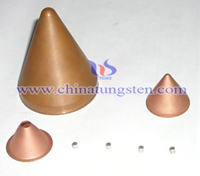Why Choose Tungsten Alloy as Shaped Charge Liners?
- Details
- Category: Tungsten Information
- Published on Friday, 19 July 2013 14:40
For the deepest penetrations, pure metals yield the best results, because they display the greatest ductility, hence postponing the breakup of the stretching jet into particles. In charges for oil-well completion, however, tungsten alloy shaped charge liner is essential that a solid slug or "carrot" not be formed, since it would plug the hole just penetrated and interfere with the influx of oil. In the petroleum industry, therefore, liners are generally fabricated by powder metallurgy, often of pseudo-alloys, which if tungsten alloy shaped charge liners un-sintered, yield jets that are composed mainly of dispersed fine metal particles.
During World War II, shaped charge liners were made of copper or steel, though other materials were tried or researched. The precision of the charge's construction and shaped charge liners detonation mode were both inferior to modern warheads. This lower precision caused the jet to curve and to break up at an earlier time and hence at a shorter distance. The resulting dispersion decreased the penetration depth for a given cone diameter and also shortened the optimum standoff distance. Since the charges were less effective at larger standoffs, side and turret skirts fitted to some German tanks to protect against Russian anti-tank rifle fire were fortuitously found to give the jet room to disperse and hence reduce its penetrating ability. Now most shaped charge liners are made of tungsten alloy.
The use of tungsten alloy shaped charge liners today may increase the penetration of some warheads. Due to constraints in the length of the projectile/missile, the built in stand-off on many warheads is not the optimum distance. The skirting effectively increases the distance between the amour and the target, providing the warhead with a more optimum standoff and greater penetration if the optimum stand-off is not drastically exceeded. Tungsten alloy shaped charge liners should not be confused with cage amour that is used to damage the fusing system of RPG-7 projectiles. The amour works by deforming the inner and outer orgies and shorting the firing circuit between the rocket's piezoelectric nose probe and rear fuse assembly. If the nose probe strikes the amour, the warhead will function as normal.
The spacing between the shaped charge liners and shaped charge liners target is critical, as there is an optimum standoff distance to achieve the deepest penetration. At short standoffs, the jet does not have room to stretch out, and at long standoffs, tungsten alloy shaped charge liners eventually breaks into particles, which then tend to drift off the shaped charge liners of axis and to tumble, so that the successive particles tend to widen rather than deepen the hole. At very long standoffs, velocity is lost to air drag, degrading penetration further.

Tungsten Manufacturer & Supplier: Chinatungsten Online - http://www.chinatungsten.com
Tel.: 86 592 5129696; Fax: 86 592 5129797
Email: sales@chinatungsten.com
Tungsten Picture Center: http://picture.chinatungsten.com
Tungsten Video Center: http://v.chinatungsten.com
Tungsten News & Tungsten Prices, 3G Version: http://3g.chinatungsten.com



 sales@chinatungsten.com
sales@chinatungsten.com